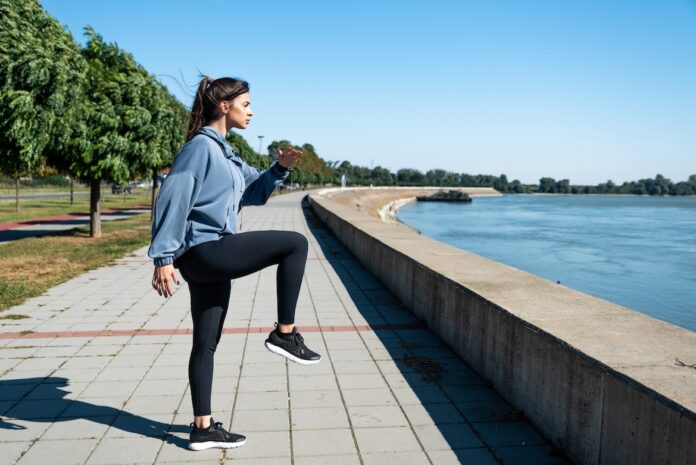The excellent news? Operating in place may simply be the unsung hero of fast, no-fuss exercises. However how does it stack up in opposition to extra conventional types of cardio, and may it actually provide help to hit your health objectives? We requested trainers to assist us dig into the science, the advantages, and why generally, staying in a single spot can nonetheless take you locations.
Does working in place depend as cardio?
As ridiculous as it’d look (or really feel), working in place does really depend as cardio. Give it some thought: The motion is just about the identical as common working, however you’re simply staying in a single spot.
It’s a incredible possibility if you wish to elevate your coronary heart fee, enhance your cardiovascular well being, and burn energy with no need a lot house or tools, in line with Jay Cardiello, CSCS, a star coach and in-house health advisor for KAILO and St. Jude’s Kids’s Analysis Hospital.
The advantages of working in place
Operating in place offers you a similar bodily advantages of different cardio workouts, however there are a couple of further bonuses, says April Gatlin, CPT, director of programming for STRIDE Health. “Operating in place presents comfort—it may be achieved wherever,” she says. “It will get your coronary heart fee up and works your decrease physique and core muscle mass, all whereas being low-impact.”
Cardiello agrees: “One of many best advantages of working in place is its accessibility—you are able to do it wherever, whether or not you are at house, in a resort room, and even throughout a fast work break,” he says.
And the perfect half is that it will possibly all be self-paced, too. “Everybody can do that at their very own tempo—rising depth if they need or scaling again if wanted—to provide themselves precisely what they want,” Gatlin says.
“One of many best advantages of working in place is its accessibility—you are able to do it wherever.” —Jay Cardiello, CSCS
Operating in place vs. working vs. strolling
Operating in place, working longer distances, and strolling all get your physique transferring, however they differ in depth, mechanics, and influence in your health objectives.
Operating in place entails transferring your legs as should you’re working, however with out protecting any distance. It’s a high-intensity exercise that elevates your coronary heart fee rapidly, making it an efficient cardio possibility, particularly when house is proscribed, in line with Cardiello. Nonetheless, it lacks the ahead momentum of conventional working, which might have an effect on how your muscle mass are engaged. Operating in place additionally emphasizes your hip flexors, calves, and quads, however doesn’t supply the identical stride-length advantages on your hamstrings and glutes.
Conventional working is a full-body cardiovascular exercise that requires house and ahead movement. It strengthens your decrease physique whereas enhancing endurance and calorie burn. The momentum from ahead motion additionally engages your core and stabilizing muscle mass extra successfully than working in place. Nonetheless, it may be tougher in your joints because of the repetitive influence, in line with the Cleveland Clinic.
A strolling exercise, then again, is completely low-impact and nice for newcomers or these recovering from accidents. Whereas it’s much less intense than working or working in place, strolling nonetheless improves cardiovascular well being and burns energy, simply at a slower tempo. Finally, the selection is dependent upon your health stage, objectives, and accessible house.
How lengthy do you have to run in place?
The size of time you must run in place all is dependent upon your objectives, Gatlin says. “Are you doing it for fast stress reduction from work? If that’s the case, [running in place] for as much as 10 minutes is enough. Are you doing it to drop a few pounds? Aiming for 20 to half-hour a number of instances every week could be ultimate. Are you utilizing it as a warmup for an additional sort of train? In that case, 30 seconds to a minute is enough.”
To make the motion efficient, Cardiello says you must intention for a minimum of 10 to fifteen minutes should you’re incorporating working in place right into a high-intensity interval exercise. “In case you’re going for a steady-state cardio session, go for 20 to half-hour. “The secret’s to take care of a tempo that challenges you whereas permitting you to remain constant.”
Tricks to maximize the effectiveness of working in place
Operating in place ought to nonetheless mimic your pure working stride, Cardiello says. With a purpose to maximize the motion, hold your core engaged, your again straight, and your arms transferring in sync along with your legs to take care of momentum.
“Concentrate on touchdown softly on the balls of your ft to soak up influence and hold your knees barely bent to keep away from overextending. Including excessive knees or butt kicks can elevate the depth and have interaction totally different muscle teams for a extra complete exercise,” Cardiello says. “Keep in mind, it’s not nearly transferring—it’s about transferring with objective and precision to maximise outcomes.”


